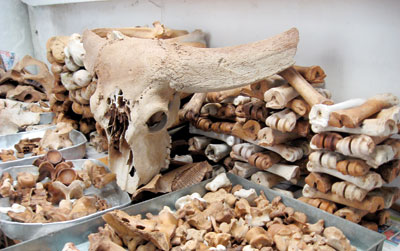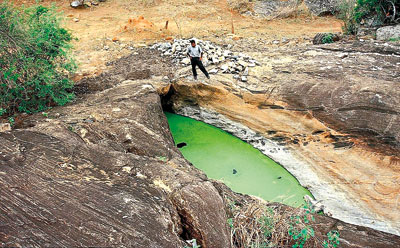News
Animal fossils thousands of years old found in Yala

The level of fossilisation indicates the animal bones are 1,000 to 5,000 years old. Pix by Rahul Samantha Hettiarachchi
Bone fragments believed to be animals that died thousands of years ago were discovered from a rock pool in Yala this week.
They are parts of skeletons of elephants, tortoises, wild buffaloes, spotted deer, wild boar and other animals, say students of the Kelaniya University Postgraduate Institute of Archaeology who are studying the fossils.
The level of fossilisation indicates the animal bones are 1,000 to 5,000 years old, palaeobiodiversity expert Kelum Manamendra-arachchie said.
“Some of these bones could be older,” he added. With time, the organic materials inside bones are replaced by mineral substances and experts can estimate their age by observing the extent of this fossilisation process.
Fossilisation only happens in rare cases. Animal carcasses are usually eaten or bacteria can rots them away before fossilisation can occur.
Fossils are found when animals die in location where their carcasses – or parts of it – are protected from scavengers and the elements, such as when they are found on the seabed or a river bed and become buried in sand, soil or mud. Rock pools with beds of clayey mud are ideal, Mr. Manamendra-arachchie pointed out.
The bones were found during efforts to find water sources for thirsty animals. Due to the drought, many of the Yala National Park’s waterholes have run dry. The Department of Wildlife Conservation (DWC) sent a crew with a backhoe to deepen a rock pool known as Wel-mal-kema in Yala Block I.
These rockpools are the lifeline of wild animals during droughts as many of them have water when other water sources run dry. It is believed animals became trapped in the mud of this rock pool when they came there for drinking water thousands of years ago.

Ther Thanamalwila rock pool
Through analysis of the bones, Mr. Manamendra-arachchie is able to surmise that wild buffaloes were plentiful thousands of years ago in Yala. The national park has a population of wild buffaloes but these are mixed with domesticated buffaloes. Mr. Manamendra-arachchie says the base of the hobes are thicker in wild buffaloes and there were many such skulls among the excavated bones.
This Wel-mal-kema is 30 feet long and believed to be 30 ft deep. Only half of it has been excavated and it is possible that there could be much older fossils.
Yala has a number of such rock pools, so there could be many mysteries waiting to be unearthed. The Director-General of the DWC and the Minister for Wildlife has requested the Institute of Archaeology to continue with this study in Yala.
Mr. Manamendra-arachchie said he analysed a similar, but smaller rock pool in 2005 in Thanamalwila from which he collected four truckloads of bones that, he believes clearly accounted for more than 100 elephants, 150 wild buffaloes, 200 spotted deer, 150 wild boar and 50 sambhur deer. Most of them had almost become fossilised.

